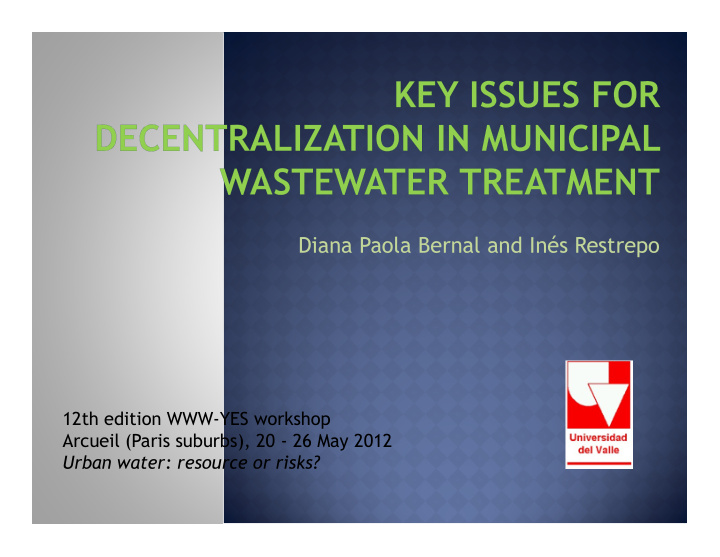



Diana Paola Bernal and Inés Restrepo 12th edition WWW-YES workshop Arcueil (Paris suburbs), 20 - 26 May 2012 Urban water: resource or risks?
Universidad del Valle Cali, Colombia
Population growth ( By 2025 will concentrate in urban areas. 80% of the population will be living in developing countries in Africa, Asia, or Latin America) (United Nations, 2007) Lack of public access to Water planning sanitation Pressure on (future demands that exceed the (2.6 billion people do not have sources of supply) access to improved sanitation water resources facilities) (WHO and UNICEF, 2010) Drinking water for some uses High treatment costs of do not require high quality wastewater standards (mainly collecting and transport) (irrigation, toilet flushing, draining, etc)
Tendency aimed at achieving a self-sustainable urban water cycle - closed-loop cycle in terms of water flows, minimises energy requirements and waste volumes discharged to the environment The new approach: integration of social, economic, and environmental aspects with practices such as rainwater management, water conservation, wastewater reuse, rational energy management (incorporating the use of alternative sources), nutrient recovery, and sorting at source. This approach can be applied to centralised and decentralised schemes or even a combination of both
The raw wastewater is treated next to the source, this approach is a viable alternative for wastewater management, minimizing the environmental impacts and facilitating the resources recovery.
Levels of decentralisation: Individual solutions, Clusters and individual buildings Semi-centralised or satellite treatment systems 3 categories: Simple sanitation systems (to assure minimum hygienic 1. standards, water pollution control less significance) Small-scale mechanical-biological treatment plant (to limit 2. water pollution, assuring a high standards of hygiene) Recycling systems (priority is the environmental protection , 3. while maintain high standards of hygiene, a common principle is separation of the different sewage or material streams - urine, feces, grey water, and stormwater).
Drivers Constraints Water crises and other new societal Government policies and regulations demands on the infrastructure founded on centralised infrastructure − Droughts and water supply shortages Market failures, with fragmentation and − Water quality and habitat degradation little information − Climate change and resilience Distorted rates of water − Aging infrastructure costs - repairs and Fragmentation of the water and sanitation expansion agencies − Alternatives to sprawl development Civil society based on the conventional (promoted by sewers and large-lot septic Minimum investment in research systems) Lack of local models that combine − Quality of life in urban and rural technology, management, financing and communities—pervasive grey infrastructure customer acceptance Population growth Segregation of actors (entrepreneurs, Water scarcity professionals, and academics) in three Resource constraints different areas: supply, storm water and Available technology wastewater Increased demand Lack of acceptance public New ideas and design concepts— natural, Lack of economic evaluations procedures social, economic systems Stove-pipe professional thinking Niche innovations by advocates and Institutional constrains entrepreneurs Existing practices Source: (Daigger, 2009, Nelson, 2008)
Parameter Centralised Decentralised Collecting system Large diameters, long distances Small diameters, short distances Requirements space Large area in one place Small areas in many places Operation and Full time technical staff Less demanding, can be monitored maintenance requirements remotely Uniformity of water Many types of water More uniform water Less control over the stormwater, More control over the stormwater, Dilution grade more dilution more concentrate Risk Risk on a larger scale Risk distributed Increase the needs for water Water is used and reused in the Water transfer transfer same area Social control Social control is lost More social control High costs, more complexity to Low cost, less complexity to Ease of expansion implementation implementation All water is concentrated in one Potential to reuse Water can be reused locally point Source: Adapted by CODESAB (2011)
Strengthening of developments Acceptance plans Social awareness on the Strengthening of legislation environment Planning Social Size Environmental Demographic Environmental DECENTRALISATION Distribution of protection population Technological Economic Efficiency Collecting and conveyance cost Reliability Treatment cost Reclamation and reuse of wastewater Combination of centralised and decentralised schemes Compliance with quality standards
Environmental pollution, water scarcity, population growth, innovation, and technological developments are drivers that encourage rethinking the current approach to urban water management. Decentralisation encourages us to think of urban water management in a holistic way, integrating all sectors, drinking water, wastewater, and stormwater to get the most benefit out of them, thereby reducing costs, improving environmental management, expanding service coverage, and considering social and environmental benefits that are not visible with the current perspective. The decentralised planning should be accompanied by a reform of policies and guidelines that govern urban development plans and water management plans in cities in developing countries.
The incorporation of decentralisation as a viable option for wastewater management in urban areas and the regulation of reuse practices such as defining quality criteria are necessary actions to articulate the conceptual framework with the actions that occur in reality. The level of decentralisation may be a critical issue to achieving sustainability of a wastewater management system. In many cases, a semi-centralised scheme can be a feasible option to introduce decentralisation in an urban area in a developing country, considering that the planning policies and the regulatory framework do not have many components that facilitate a different kind of management than the traditional "end-of-the-pipe" solutions and with use of conventional technologies in centralised systems
Recommend
More recommend